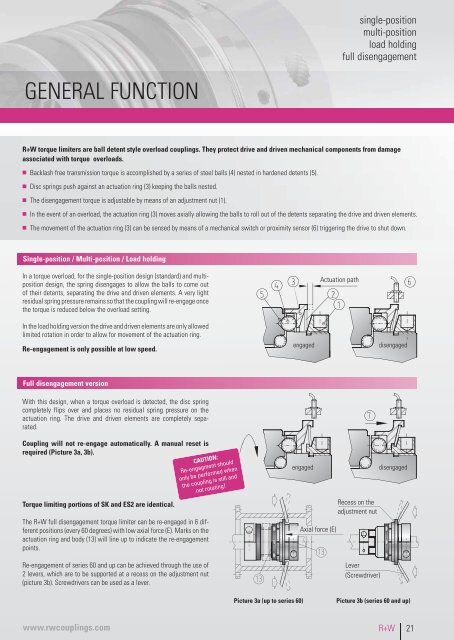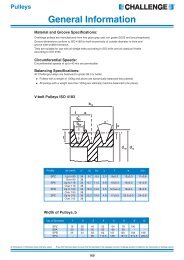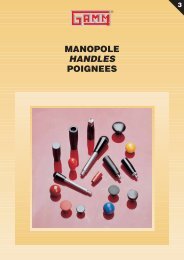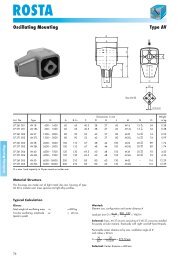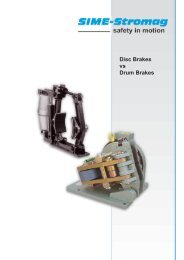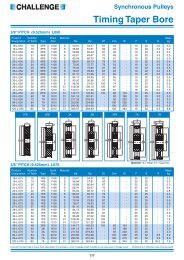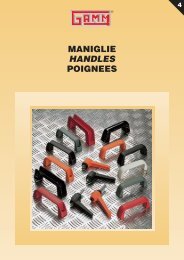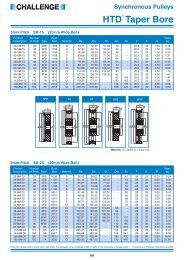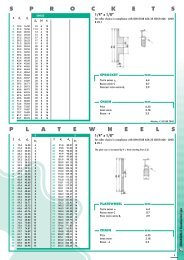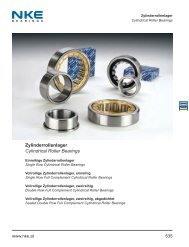TORQUE LIMITERS
TORQUE LIMITERS
TORQUE LIMITERS
Create successful ePaper yourself
Turn your PDF publications into a flip-book with our unique Google optimized e-Paper software.
single-position<br />
multi-position<br />
load holding<br />
full disengagement<br />
GENERAL FUNCTION<br />
R+W torque limiters are ball detent style overload couplings. They protect drive and driven mechanical components from damage<br />
associated with torque overloads.<br />
■ Backlash free transmission torque is accomplished by a series of steel balls (4) nested in hardened detents (5).<br />
■ Disc springs push against an actuation ring (3) keeping the balls nested.<br />
■ The disengagement torque is adjustable by means of an adjustment nut (1).<br />
■ In the event of an overload, the actuation ring (3) moves axially allowing the balls to roll out of the detents separating the drive and driven elements.<br />
■ The movement of the actuation ring (3) can be sensed by means of a mechanical switch or proximity sensor (6) triggering the drive to shut down.<br />
Single-position / Multi-position / Load holding<br />
In a torque overload, for the single-position design (standard) and multiposition<br />
design, the spring disengages to allow the balls to come out<br />
of their detents, separating the drive and driven elements. A very light<br />
residual spring pressure remains so that the coupling will re-engage once<br />
the torque is reduced below the overload setting.<br />
Actuation path<br />
In the load holding version the drive and driven elements are only allowed<br />
limited rotation in order to allow for movement of the actuation ring.<br />
Re-engagement is only possible at low speed.<br />
engaged<br />
disengaged<br />
Full disengagement version<br />
With this design, when a torque overload is detected, the disc spring<br />
completely flips over and places no residual spring pressure on the<br />
actuation ring. The drive and driven elements are completely separated.<br />
Coupling will not re-engage automatically. A manual reset is<br />
required (Picture 3a, 3b).<br />
Torque limiting portions of SK and ES2 are identical.<br />
The R+W full disengagement torque limiter can be re-engaged in 6 different<br />
positions (every 60 degrees) with low axial force (E). Marks on the<br />
actuation ring and body (13) will line up to indicate the re-engagement<br />
points.<br />
Re-engagement of series 60 and up can be achieved through the use of<br />
2 levers, which are to be supported at a recess on the adjustment nut<br />
(picture 3b). Screwdrivers can be used as a lever.<br />
CAUTION:<br />
Re-engagment should<br />
only be performed when<br />
the coupling is still and<br />
not rotating!<br />
engaged<br />
Axial force (E)<br />
Recess on the<br />
adjustment nut<br />
Lever<br />
(Screwdriver)<br />
disengaged<br />
Picture 3a (up to series 60)<br />
Picture 3b (series 60 and up)<br />
www.rwcouplings.com<br />
R+W<br />
21


